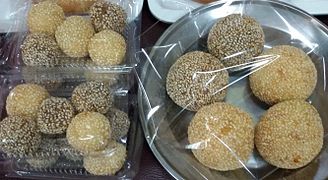Jian dui
 | |
| Alternative names | matuan, sesame ball |
|---|---|
| Course | Pastry |
| Place of origin | Chang'an (now Xi'an), Tang dynasty China |
| Region or state | Chinese-speaking areas, Indonesia, Malaysia, Vietnam, Japan, Philippines, Sri Lanka, India |
| Main ingredients | glutinous rice flour, sesame seeds, various fillings (lotus seed, black bean, red bean pastes) |
| Jian dui | |||||||||||||||||
|---|---|---|---|---|---|---|---|---|---|---|---|---|---|---|---|---|---|
| Chinese | 煎䭔 煎堆 | ||||||||||||||||
| Literal meaning | fried pile | ||||||||||||||||
| |||||||||||||||||
| Matuan | |||||||||||||||||
| Traditional Chinese | 麻糰 | ||||||||||||||||
| Simplified Chinese | 麻团 | ||||||||||||||||
| Literal meaning | sesame rice dough | ||||||||||||||||
| |||||||||||||||||
Jian dui (Chinese: 煎堆; Jyutping: zin1deoi1; Cantonese Yale: jīndēui) is a type of fried Chinese pastry made from glutinous rice flour. The pastry is coated with sesame seeds on the outside and is crisp and chewy. Inside the pastry is a large hollow, caused by the expansion of the dough. The hollow of the pastry is filled with a filling usually consisting of lotus paste, or alternatively sweet black bean paste, or less commonly red bean paste. They are also sometimes referred to as sesame balls (Chinese: 芝麻球; pinyin: zhīmáqíu; Jyutping: zi1maa4kau4; Cantonese Yale: jīmàhkàuh).[1]
Depending on the region and cultural area, jian dui are known as matuan (麻糰) in northern China, ma yuan (麻圆) in northeast China, and zhen dai (珍袋) in Hainan. In American Chinese restaurants and pastry shops, they are known as sesame seed balls.[2]
Origin
The origins of jian dui can be traced back to the Tang dynasty as a palace food in Chang'an, known as lüdui (碌堆). This food item was also recalled in a poem by the Tang poet Wang Fanzhi. With the southward migration of many peoples from central China, the jian dui was brought along and hence became part of southern Chinese cuisine.
Regional
Hong Kong
In Hong Kong, it is one of the most standard pastries. It can also be found in most Chinatown bakery shops overseas.[3]
India and Sri Lanka
In Tamil Nadu and North-East of Sri Lanka, it is known as Ellu Urundai or Ellurundai (எள்ளுருண்டை). The local word meaning: sesame ball. It comes with different sizes and colors. It is usually filled with sesame seeds, jaggery or sugar and glucose syrup.[4]
Indonesia
In Indonesian cuisine, it is called onde-onde, filled with sweetened mung bean paste. People usually eat it as snack. This pastry is also popular and widely available in Indo (Eurasian), Indonesian and Vietnamese outlets in the Netherlands.
Japan
In Japan, it is known as goma dango (ごま団子, sesame dumpling). It is often sold at street fairs, in Chinese districts, and at various restaurants.
Korea
In Korea, it is called chamkkaegyeongdan(참깨경단, "sesame rice ball cake"), or Jungguksik chamkkaegyeongdan(중국식 참깨경단, "Chinese-style sesame rice ball cake") to avoid confusion with Korean-style sesame rice ball cake(gyeongdan) with sesame coating. As the Chinese jian dui is first coated with sesame seeds then deep-fried while the Korean gyeongdan is first steamed then coated with toasted sesame seeds, jian dui is also called twigin chamkkaegyeongdan(튀긴 참깨경단, "deep-fried sesame rice ball cake").
Malaysia
It is known as kuih bom, which is usually filled with shredded sweetened coconut, or nuts. Occasionally, it may be filled with red bean paste.
Among the mainly Hakka-speaking ethnic Chinese in the state of Sabah, jian dui is more commonly known as 'you chi'.
Philippines
In the Philippines, jian dui is called butsi (Castilian: buchi). Due to hundreds of years of Chinese settlement in the Philippines, the integration of Chinese cuisine (particularly Cantonese and Fujian) to local dishes has made buchi quite popular. To an extent, it has already been considered an icon of Chinese Filipino culinary tradition, sometimes associated with auspiciousness. As it is well-known among ethnic Chinese and other Filipinos alike, local restaurants which are sometimes not even Chinese and fastfood chains such as Chowking[5][6] have added the delicacy to the menu. Aside from the usual lotus and red bean paste, non-Chinese and indigenous ingredients have also been used for variety such as ube-flavored butsi.[7]
Vietnam
In Vietnam, two very similar dishes are called bánh cam (from southern Vietnam) and bánh rán (from northern Vietnam), both of which have a somewhat drier filling that is made from sweetened mung bean paste.[8] Bánh rán is scented with jasmine flower essence (called mali in Thai).photo
Bánh rán can be sweet or savory. The sweet one is filled with mung bean. The savory one is filled with chopped meat, cassava vermicelli, mushroom, and a variety of other typically Vietnamese ingredients. It's usually served with vegetable and dipping sauce.
Gallery
-
Jian dui can be fried to great sizes.
-
Chinese Jiandui with Black & White Sesame
-
Chinese Jiandui with Fillings and Black & White Sesame
-
Ellurundai, sesame ball in Sri Lanka.
-
Onde-onde from Surabaya, Indonesia. The yellow ones were made from white glutenous rice flour while the black ones from black glutenous rice flour.
-
Philippine butsi or buchi variant covered with white sugar and filled with bukayo (coconut flesh strips simmered in sugar syrup).
See also
References
- ^ Misty, Littlewood and Mark Littlewood, 2008 Gateways to Beijing: a travel guide to Beijing ISBN 981-4222-12-7, pp. 52.
- ^ "Dim Sum Menu Translator – Chinese Cuisine". Retrieved 2009-12-01.
- ^ Sesame Balls by Ching He Huang
- ^ "Ellurundai - Sweet Sesame Balls". Retrieved 9 September 2015.
- ^ [1]
- ^ [2]
- ^ [3]
- ^ pwmf blogspot







